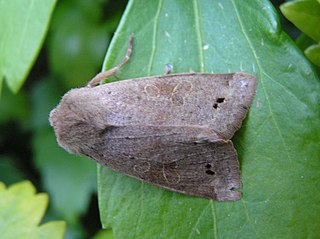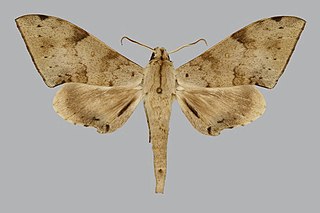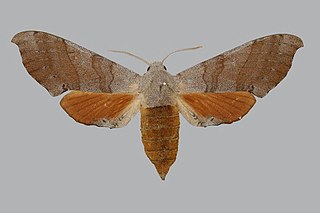
The twin-spotted Quaker is a species of moth of the family Noctuidae. The wings are gray, with two closely approximate and very conspicuous dark spots on the disc of the fore wings. a small dark apical mark at the costal edge and a discal spot on the fuscous hindwings. It is found in Palearctic ecozone.

Virbia is a genus of tiger moths in the family Erebidae.

Virbia aurantiaca, the orange holomelina, is a moth species of the family Erebidae found in North America. In the east it has been recorded from Manitoba and Nova Scotia, south along the eastern seaboard to Cordoba in Mexico. It has also been recorded from Texas, Mississippi, Missouri, Tennessee, Louisiana, Oklahoma, Kansas, North Dakota and South Dakota.

Polyptychus nigriplaga is a moth of the family Sphingidae. It is known from central and west Africa.

Polyptychus coryndoni is a moth of the family Sphingidae. It is known from Brachystegia woodland from Zimbabwe to Malawi, Zambia, the Democratic Republic of the Congo and Tanzania. It has also been recorded from northern Nigeria.
Neopolyptychus serrator is a moth of the family Sphingidae. It is known from forests from the Congo to Uganda and western Kenya. It is also known from Cameroon.
Lemyra boghaika is a moth of the family Erebidae. It was described by Tshistjakov and Kishida in 1994. It is found in the Russian Far East and Korea. It is probably also present in China.
Phragmatobia assimilans, the large ruby tiger moth, is a moth in the family Erebidae. It was described by Francis Walker in 1855. It is found from Nova Scotia to Connecticut, in the east to British Columbia. There are isolated populations in northern Colorado and the Black Hills of South Dakota. The habitat consists of open meadows and moist forests.
Virbia costata is a moth in the family Erebidae. It was described by Stretch in 1884. It is found in the western United States, ranging to western Oklahoma in the east and Colorado in the north.
Virbia fergusoni is a moth in the family Erebidae. It was described by Zaspel in 2008. It is found in the south-eastern United States, ranging to South Carolina in the north and from Georgia and northern Florida to Alabama in the west. The habitat consists of mixed oak-pine forests.
Virbia ferruginosa, the rusty holomelina, is a moth in the family Erebidae. It was described by Francis Walker in 1854. It is found from Nova Scotia to British Columbia in Canada. In the United States it is found from the northeast and upper Midwest, south to Virginia, Mississippi, Missouri and Louisiana.
Virbia fragilis is a moth in the family Erebidae. It was described by Strecker in 1878. It is found in open fields in the Black Hills in South Dakota and in Boulder, Colorado. The range extends north to Alberta and British Columbia and south to New Mexico.
Virbia immaculata, the immaculate holomelina or plain-winged holomelina, is a moth in the family Erebidae. It was described by Reakirt in 1864. It is found from the eastern coast of North America west to Manitoba. It has also been recorded in Iowa, Illinois and Indiana.

Virbia laeta, the joyful holomelina, is a moth in the family Erebidae. It was described by Félix Édouard Guérin-Méneville in 1844. It is found in North America from New Brunswick south to Florida and west to Minnesota and south to Texas. The habitat consists of pine woodlands.
Virbia lamae, the bog holomelina, is a moth in the family Erebidae. It was described by Freeman in 1941. It is found in Nova Scotia, New Brunswick, Maine, Wisconsin and Michigan. The habitat consists of open peat bogs.
Virbia marginata is a moth in the family Erebidae. It was described by Herbert Druce in 1885. It is found in Mexico, Guatemala, Honduras, New Mexico and Arizona.
Virbia nigricans is a moth in the family Erebidae. It was described by Reakirt in 1864. It is found in secondary secession habitats in western New Jersey and Pennsylvania.
Virbia ostenta, the showy holomelina, is a moth in the family Erebidae. It was described by Henry Edwards in 1881. It is found in the mountain ranges of New Mexico, Arizona and Mexico.
Virbia rindgei is a moth in the family Erebidae. It is found in Colorado, South Dakota and Wyoming. The habitat consists of ponderosa pine forests.

Virbia rubicundaria, the ruddy holomelina, black-banded holomelina or least holomelina, is a moth in the family Erebidae. It is found from Georgia and Florida, along the Gulf Coast to eastern Texas.









